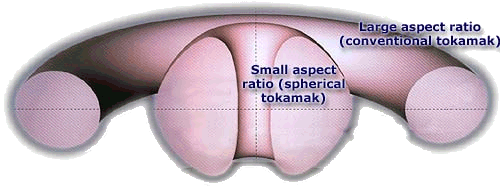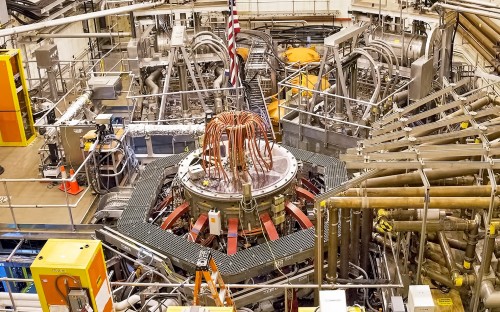The National Spherical Torus Experiment (NSTX) was built at the Princeton Plasma Physics Laboratory (PPPL) and started operation in 1999. The goal of the device is to study the physics of spherically shaped fusion plasmas, which are claimed to have several advantages over the traditional doughnut-shaped plasmas. Consequently, there is considerable interest in these devices, even though they are effectively one generation behind traditional tokamaks, such as JET.
Spherical Tokamaks
A spherical tokamak differs from the conventional tokamak design in the fact that the spherical tokamak has a relatively small aspect ratio. This means that spherical tokamaks typically have a rather small major radius and a rather large, often elongated, minor radius. Consequently, the volume in the core of the reactor that is occupied by the central solenoid, is as small as possible, resulting in a nearly spherical plasma.

Spherical tokamaks in comparison to the conventional doughnut-shaped tokamaks. [Source: Culham Centre of Fusion Energy]
Spherical tokamaks are generally more compact than their traditional counter-parts, as a result of which its magnets can be much smaller and are on average much closer to the plasma. This has several benefits.
First of all, due to their compactness, spherical tokamaks are able to achieve higher magnetic pressures at a given magnetic field. Since the fusion power scales with the square of the pressure, this means that spherical tokamaks are able to achieve higher output powers.
Moreover, the plasma within spherical tokamaks can be stabilized with magnetic fields that are much smaller (up to a factor of ten) than the fields of non-spherical tokamaks, as a consequence of which the machines may not need superconducting magnets. Both the fact that its coils can be much smaller and that they do not necessarily have to be superconducting, leads to a large reduction in the construction costs of spherical tokamaks.
These advantages, however, come at a cost. The compactness of the device does not allow a breeding blanket and neutron shielding near the central solenoid, which means that superconductors cannot be used. And even though copper coils are less expensive than the superconducting ones, they will have to be replaced regularly, due to the lack of neutron shielding. Another problem of copper coils is that they can only generate a limited magnetic field and they dissipate a considerable amount of power, reducing the efficiency of spherical tokamaks.
Also, spherical tokamaks require a much larger toroidal current in order to sustain the asymetric plasma cross-section. For this current, spherical tokamaks rely on external current drive (which reduces their efficiency) or relatively large Bootstrap fractions. The elongation and triangularity of the spherical design helps to achieve this, but these do cause resistive wall mode instabilities which have to be dealt with.
NSTX-U: the world's most powerful spherical tokamak
In 2012 Princeton’s NSTX was temporarily closed for a $94 million upgrade, funded by the U.S. Department of Energy. Last month - after a construction period which lasted nearly four years - NSTX-U was reopened, making the device the most powerful spherical tokamak in the world.
The $94 million have been used mainly to replace the central solenoid within the core of the machine and to add a second neutron beam injector. The combined effect of both upgrades enables NSTX-U to run with a twice as large magnetic field strength and double the plasma current, extending the pulse duration from one to five seconds and increasing the temperature at the core of the plasma with a factor of two.

Topview of the upgraded National Spherical Torus Experiment (NSTX-U).
Please, see the photos of the Month for more impressive images.
A testbed for possible next-generation spherical tokamaks
The upgrade of NSTX to NSTX-U will allow scientists to address several issues that are critical for the ‘spherical tokamak’-concept at conditions that more closely resemble a potential fusion power plant. These issues include challenges concerning reactor materials, current drive and plasma confinement.
It is, for instance, unknown whether spherical tokamaks are able to confine the fusion plasmas effectively at longer pulse durations and higher plasma temperatures. Furthermore, it will be investigated how the upgraded NSTX-U device copes with the higher power flux, which might lead to more wall damage and an increased amount of impurities within the reactor.
Finally, alternative current drive methods will be tested for future designs, because the operation conditions that are required for these machines will probably damage the central solenoid.
In summary, the upgraded NSTX-U will test the ability of spherical tokamaks to maintain a high-performance plasma under conditions of extreme heat and power. In that sense, NSTX-U serves as an ideal testbed for possible next-generation spherical tokamaks and could strongly influence the design of future fusion reactors.
See also:
- PPPL news: NSTX-U reopened after major upgrade
- PPPL news: Planned NSTX Upgrade
- Culham Centre for Fusion Energy: Spherical Tokamaks Explained
